#took inspiration from Kanan's concept arts
Text
Took Kanan shopping, my man needs more outfits.
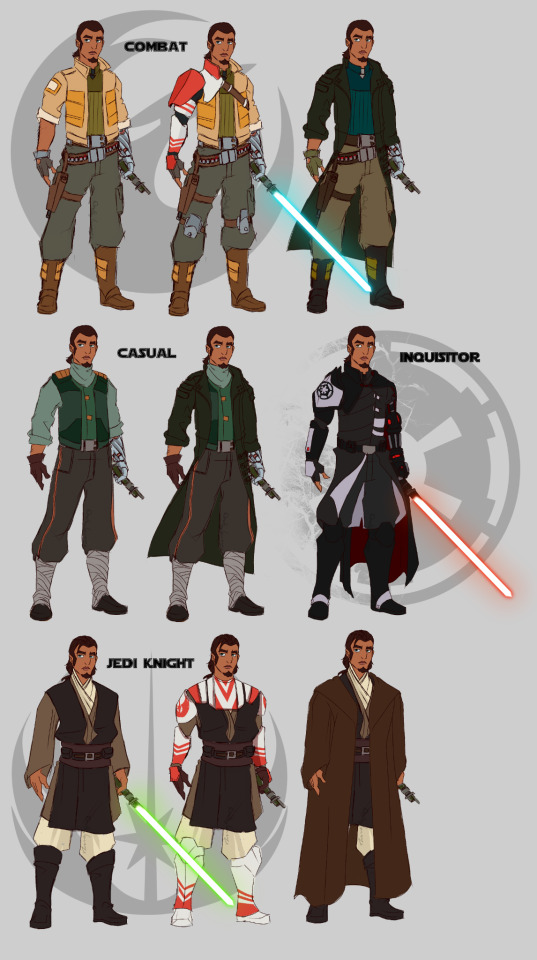
Please don't repost my art without permission thanks 💞
#kanan jarrus#star wars rebels#swr fanart#took inspiration from Kanan's concept arts#hence the prosthetic arm#also some clone wars#commander grey colors#like I know he would probably never wear it but maybe after befriending Rex..?#it just looks cool imo#idc about canon obviously
641 notes
·
View notes
Text
This is from the concept art of Rebels and Chubby Hera is what I needed in life 💕
I took the picture from Kanan Jarrus-Core, his book.

And got a bit inspired 💕

#star wars#star wars rebels#concept art#hera#hera syndulla#chubby hera#chubby#twilek#twi'lek#scketch#bad sketch
20 notes
·
View notes
Text
Inspired by spending perhaps a little too long (if that’s possible) on blogs like the amazing @sundownsquad, I’ve been experimenting with drawing the main characters of my Clone Wars and CW-adjacent series. A MSE-6 could probably do a better job, but here goes. Each picture will also have a quick character description and some author’s and design notes associated with it.
First up is my main point-of-view character, Jedi Knight (later Master) Helli Abbasa (Hel for short).

Description
Gentle but fierce, passionate and compassionate, Helli is one of the Jedi Order’s less conventional members. While she’s wholly committed to the Jedi Code and to her own code of honour, she follows both sets of rules on her own terms, and is something of an expert on bending them to suit the situation. She is prepared to give her life for those she loves (an extremely broad category), but is sufficiently skilled in both combat and diplomacy that the question seldom arises. Her total commitment to the preservation of life means that anyone who makes the mistake of crossing her is all but guaranteed to live to regret it.
(The rest of this post contains spoilers for my fics and some philosophical meandering, and hence is - hopefully; I’m very new to all this - under the cut.)
Author’s Notes
Helli started out as a self-insert character (I have very little imagination when it comes to creating new characters), but took on a life of her own pretty quickly. Alba is meant to be a Star Wars version of Scotland (I’m part-Scottish myself, and as keen on its history and culture as only an expat can be), but Helli’s beliefs are very Catholic. I wanted to explore the interplay between a fully pro-life, non-dualistic perspective and the realities of a galaxy at war, as well as certain Jedi ideas I find it hard to accept (the dismissal of God’s creation as “crude matter” springs to mind). Being Catholic does make it easier for me to understand the concept of giving up marriage and a family the better to follow one’s true vocation, hence Helli and Torrent’s arc. That development did blindside me somewhat; it just sprang fully-formed from their chemistry in the first story. So did the idea that it would be Torrent who “executes” Helli when Order 66 is declared. (I actually wrote that long before reaching the conspiracy arc in Season 6, so some hasty editing was required.)
Originally, Helli was just going to be a “normal” Jedi, with no special abilities or links to the main characters. I did relent and give her outstanding combat skills and intuition, but they’re (a) less important to her than other gifts and (b) the result of hard work as well as talent. Her problems with telekinesis - which seems to be easy for most Jedi - may have been an attempt to compensate for that. It also became impossible to keep the Disaster Lineage out of her storyline entirely; I eventually settled on the idea that Helli knows Anakin by reputation when they’re younger, and they train together, but she’s too much in awe of him for them to become proper friends until she’s gained a lot more self-confidence. I’m perhaps unwisely fond of their dynamic as padawans and young knights, taking it in turns to teach and encourage one another, given Anakin’s future. The idea that Helli trained Kanan in unarmed combat started out as an excuse for her to recognise him twenty years on, but I’ve come to like the notion that the skills she taught both Kanan and Anakin, which they passed on to Ezra and Ahsoka, had more of an influence than anyone could have predicted.
Helli’s style of unarmed combat is based on tae kwon-do, the martial art I know best, which is focused on self-defence and defence of the weak. She has a dual-blade lightsabre to maximise her defensive capacity, and a mix of styles that gives her plenty of flexibility. Forms II, III and VI seemed to suit her, as they emphasise control, defence and balance respectively; Form V, her fourth favourite, was a pragmatic choice, more aggressive but better for situations involving blasters. Her below-average agility and quick temper ruled out Forms IV (too acrobatic) and VII (relies on using one’s anger without being controlled by it; a favourite of Master Windu’s) respectively. She’s uneasy about using a blaster because it’s intended to be purely an offensive weapon, but when she can’t use her sabre a quarterstaff - the traditional choice of the naturally non-violent since Robin Hood’s day at least - is the next best thing.
I may have made a mistake by writing Helli as non-human, and therefore an ethnic minority, when I’m ethnic-majority myself, but that was how she occurred to me. It gave me the opportunity to write from an outsider’s perspective, which I always enjoy, play around with xenobiology (I’m a pharmacologist by training) and even slip in the odd bit of anti-colonial commentary.
On a more personal note, Helli’s my third main OC, but easily the one with whom I’ve spent the most time, and the one who’s helped me the most. When the sassy Scottish Catholic elf first walked into my head, I was still adjusting to being a PhD student, suffering from anxiety for the first time in my life, and failing to pluck up the courage to tell someone how I felt about him. Things did not get better in the next few months. I developed full-on OCD, my PhD has been one long series of crises so far, and the one person for whom I’ve ever really had feelings has stopped reading my messages. The first two problems have partly been resolved now, but life’s not yet back to normal in any sense. Writing has been one way I’ve kept myself halfway sane during a year from purgatory, and when things were at their worst, channelling Helli’s courage and refusal to give up sometimes pulled me through. If Himself had anything to do with my creating her (and I now suspect He did), that was a very good call on His part.
Design notes
As mentioned above, Helli started out as a self-insert, so her design is a modified self-portrait. If I could draw muscles and scars realistically, she’d have plenty of both (though all the scars I know about are under her clothes). I don’t know exactly why I went for pointed ears as an indicator of her species, other than too much Star Trek, Lord of the Rings (specifically the films) and general fantasy. She wears traditional Jedi robes when she can, but alters them for greater efficiency in combat; the colour scheme was chosen to suit her/my colouring, long before I knew she was loosely attached to the 501st. I picked durasteel for her lightsabre as a practical, hard-wearing, unfussy metal, adding the copper bands because there’s more to life than the basics, and not realising that Shaak Ti (whom Helli and I both admire) uses the same combination. The carbon fibre and silicone grip was a purely practical addition, as metal is very sensitive to temperature changes, not to mention low-friction. The turquoise blades show that while she’s emphatically Light Side, she isn’t a typical Jedi. I came across the sgian dubh in a collection of short stories about life in a Highland regiment, which was a primary source for Helli’s relationship with her men early on and for Alban culture, and it just worked its way into a plot. Once it was there, I felt I had to keep using it.
(Side design note: Helli’s ears were pierced six weeks before she turned eighteen so that her first “proper” pair of earrings could be a birthday present from her master. In real life, one’s very first earrings have to stay in place for at least six weeks, being cleaned regularly, kept dry and generally mollycoddled. For me at least, the first pair of earrings that weren’t those were - and still are - special.)
0 notes
Photo

ILM Shares ‘Star Wars Stories’ at Gnomon
ILM’S Paul Giacoppo, Charmaine Chan, and Jay Machado discuss their career paths, making Rogue One, and much more.
From the opening shot until those final moments before the Tantive IV takes off into hyperspace, Rogue One’s visual storytelling takes center-stage in a big way. The credits run long for a reason, and that’s because hundreds of people at Industrial Light & Magic worked tirelessly to bring every major visual to life in a way that felt both “classic” and new at the same time. Last month at Gnomon University in Los Angeles, three of those visionaries brought their work to an audience of eager visual effects students in a special presentation called Star Wars Stories: An Evening with ILM. ILM’s Paul Giacoppo, Charmaine Chan, and Jay Machado brought decades’ worth of experience to their discussion.
Machado was on the modeling team for The Force Awakens’ Millennium Falcon, and created the award-winning Imperial Star Destroyer that we see rise from the shadows in Rogue One. Charmaine Chan spoke of her history at ILM, illustrating how careers grow and change on the company’s campus. Giacoppo is behind some extremely recognizable work that reaches back decades over the history of Lucasfilm and ILM; the crowd was hooked when he showed off his visually memorable “Hulk Smash” shot from Marvel’s Avengers.
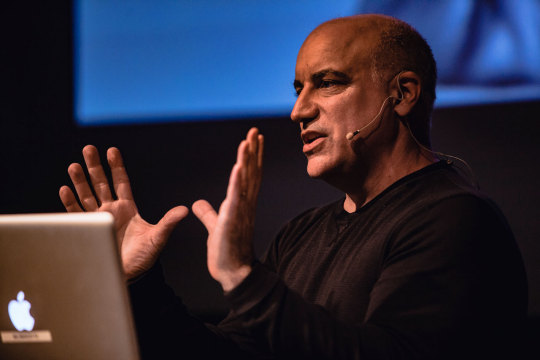
But while their extensive careers could take up an entire editorial on their own, the focus of the evening was visual storytelling, and how ILM created Rogue One. Giacoppo outlined the overall objective of what the team wanted fans to see and understand: “The idea behind our work on Rogue One was that it had to have the visual feel of the classic 1977 Star Wars, but have a new vision as well.”
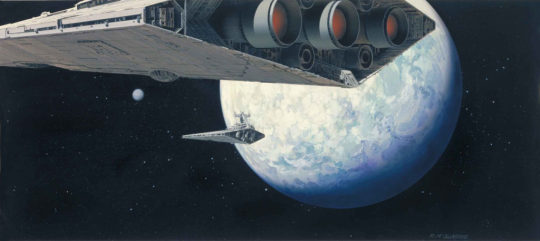
When it came to seeking out inspiration, the team had to look further than the usual standards. They began with concepts by Ralph McQuarrie, Joe Johnson, and several others that defined the look of Star Wars. These angular, expansive, and recognizable styles still reflect throughout Rogue One, but the team looked at what they could do differently as well, because the story in itself was different from the norm. “[McQuarrie and Johnson’s concepts] were part of what the visual language of Rogue One was,” said Giacoppo. “But it was a different kind of movie. It was a true war movie, about people with a mission to complete. So it’s not exactly a ‘hero’s journey,’ and we had to change what we were doing in order to tell this different kind of story.”
Giacoppo dove into set design, then, showing off digital recreations of classic sets that were created by John Knoll, ILM’s chief creative officer and a staple of Star Wars creativity. Knoll, attempting to explain how characters would move through various scenes, created digital set tours practically overnight in order to explain his vision.
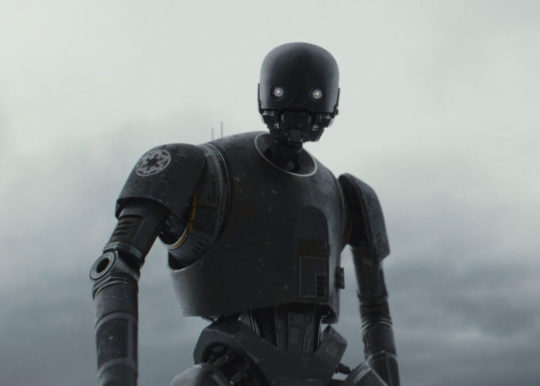
Giacoppo then dove into characters that were created digitally for the film, focusing first and foremost on K-2SO, who he says has been part of the Rogue One story since its original pitch. K-2SO varied greatly from past on-screen droid companions, who were so often cute, or at least a little more friendly-looking. “He’s intimidating, he’s really stealthy, and he’s huge… and he was always an Imperial enforcer droid.
“There was a lot of time spent with the texture artists to get those same materials and weathering we’re used to in Star Wars,” Giacoppo explained, noting the details that showed Kaytoo’s age and length of use.
The team took designing Kaytoo very seriously, spending hours on specific details about how he would emote. The team looked at more eyes than one can count on two hands, then went through tests of how they would move — if at all — and how Kaytoo looked when expressing himself. “There was a big push to have a part of him blink, and to have a part of him move his mouth,” said Giacoppo, noting that such a thing is a rarity among Star Wars droids, who often reflect a much more industrial feel in design than most AI-driven beings within the genre. “But it just didn’t feel like Star Wars. See, he’s all blinking and jittering around… there’s too much going on.” With animation supervisor Hal Hickel’s guidance, the team ultimately went with “this sort of more impassive mask”, said Giacoppo, allowing fans to read and “project” emotions onto Kaytoo as they got to know him.
As a special bonus, Giacoppo showed a tiny clip of K-2SO playing with toys that paired with some very familiar audio from Alan Tudyk’s Wash in Firefly (“Curse your sudden but inevitable betrayal!).

ILM’s Jay Machado, a hard-surface modeler and texture artist, was a welcome and familiar face that evening. As a Gnomon alum himself, Machado’s post-grad years have been more than exciting. For Rogue One, following his Millenium Falcon re-creation, Machado was tasked with creating iconic ship-looks once again. To set the tone for the talk, Machado showed off that iconic opening shot from A New Hope, where the belly of the Star Destroyer sails over the camera in pursuit of Princess Leia’s Tantive IV. “We wanted it to feel like the exact same era,” said Machado. So, his team at ILM went to the root of all builds to recreate and design ships in Rogue One. “For the ships, we went up to the archives, we took lots of photos, we scanned things, stuff like that — all to get the ships to be just right,” Machado told the crowd. “There’s a few people still working at ILM that we were able to talk to, like [long-time ILM VFX artist and supervisor] Dennis Muren, who [shot] much of this originally, and that really helped when it came to making it accurate.
“What I was surprised by is that the original Star Destroyer is only three feet long…a lot of the panel lines are drawn in with pencil. And we wanted to match that so that in a way, you could watch Rogue One and seamlessly start A New Hope.”
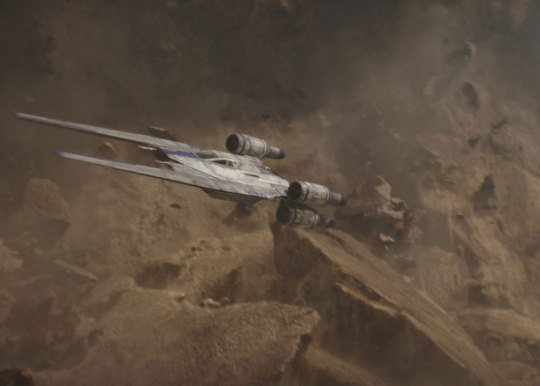
As far as new ships went, Machado noted that the tasks were just as difficult, but worth every grueling second. “Working with Doug Chiang and the art department, we had to design [the new ships] in a way that felt familiar so that they would blend in seamlessly with the ships we know and love.” Machado highlighted the U-wing, Krennic’s ship, and the new TIE strikers, stating that they were kind of meant to “compliment” the U-wing, with forward-sweeping panels and a unique, planet-specific use.
What may have been most exciting was the creation of new ships to the canon, like the Ghost from Star Wars Rebels, which featured on screen twice in Rogue One. “It fell to me to actually [build the Ghost] and it was kind of a secret project,” said Machado. “Well, at first it was a secret. Nobody else was supposed to know about it. I was supposed to do this quickly, and I had to design it in between my daily work so that people within the office wouldn’t start getting suspicious,” he joked. There are panels and pieces that might look familiar, too — parts of the Ghost might look similar to the Falcon, and that’s no mistake.
One other major ship from Rebels that ended up in Rogue One came all the way from the Knights of the Old Republic games, originally. Hammerhead cruisers, which Princess Leia worked with Kanan Jarrus and Ezra Bridger to steal for the Rebellion in Star Wars Rebels, played an integral part in Rogue One, and Machado was among those responsible for their finished designs on the big screen.
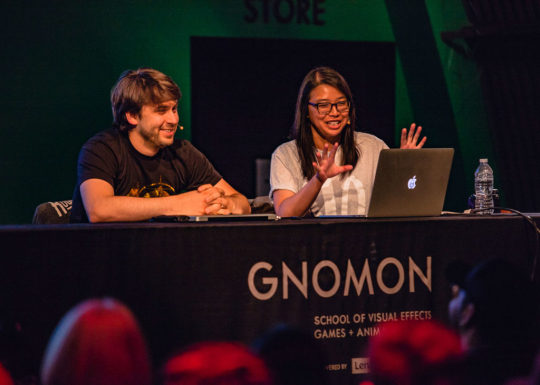
Charmaine Chan’s presentation focused more on the process of growing her career before and after ILM. As an up-and-coming artist who veered off the trail that her parents originally wanted (worry not — they were ultimately supportive either way), Chan hit the ground running by creating work early and producing it every day. Since joining ILM, Chan has worked on more movies than one can count — a once-over of her IMDB page shows credits for Transformers, Captain America: Civil War, Jurassic World, and more. But her beginnings were in Web development.
According to Chan, she learned HTML, CSS+, and more “so that I could build Spice Girls websites” as a little girl. As that hobby grew, Chan broke into graphic design, then Flash animation. (As someone who started her career building Star Wars and N*SYNC fansites, this writer can relate.) “That’s what really started all of this, because I started watching movies closer and learning what it took to compose a full shot. There’s lightning, texture, and all sorts of details to consider, which I found really interesting…it really helped me move into this form of art.” Chan took those skills to the next level, learning visual effects, making motion graphics (“You know, like, DVD menus!” she joked) and eventually applying for a digital research position at ILM. “That gave me a really great overview of what the VFX process is,” said Chan. “I got to touch the shots at the beginning and the end.” From there, she kept working her way into a position at ILM that has grown and spanned over a decade, leading to her work as a compositor today.

The night was a wonderfully informative look at how the story of Rogue One was brought to to the big screen with stunning, modern, yet familiar visuals. One of the biggest surprises for this writer was learning about the sheer scale of people working on each Star Wars film. Hundreds of names scroll down through the credits after every film, but there’s just something unique and different about putting faces to those names and realizing just how many people it takes to make our favorite galaxy far, far away come to life.
14 notes
·
View notes